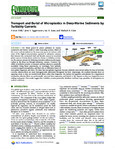Transport and Burial of Microplastics in Deep-Marine Sediments by Turbidity Currents
| dc.contributor.author | Pohl, Florian | |
| dc.contributor.author | Eggenhuisen, JT | |
| dc.contributor.author | Kane, IA | |
| dc.contributor.author | Clare, MA | |
| dc.date.accessioned | 2021-03-16T11:46:22Z | |
| dc.date.available | 2021-03-16T11:46:22Z | |
| dc.date.issued | 2020-04-07 | |
| dc.identifier.issn | 0013-936X | |
| dc.identifier.issn | 1520-5851 | |
| dc.identifier.uri | http://hdl.handle.net/10026.1/16946 | |
| dc.description.abstract |
The threat posed by plastic pollution to marine ecosystems and human health is under increasing scrutiny. Much of the macro- and microplastic in the ocean ends up on the seafloor, with some of the highest concentrations reported in submarine canyons that intersect the continental shelf and directly connect to terrestrial plastic sources. Gravity-driven avalanches, known as turbidity currents, are the primary process for delivering terrestrial sediment and organic carbon to the deep sea through submarine canyons. However, the ability of turbidity currents to transport and bury plastics is essentially unstudied. Using flume experiments, we investigate how turbidity currents transport microplastics, and their role in differential burial of microplastic fragments and fibers. We show that microplastic fragments become relatively concentrated within the base of turbidity currents, whereas fibers are more homogeneously distributed throughout the flow. Surprisingly, the resultant deposits show an opposing trend, as they are enriched with fibers, rather than fragments. We explain this apparent contradiction by a depositional mechanism whereby fibers are preferentially removed from suspension and buried in the deposits as they are trapped between settling sand-grains. Our results suggest that turbidity currents potentially distribute and bury large quantities of microplastics in seafloor sediments. | |
| dc.format.extent | 4180-4189 | |
| dc.format.medium | Print-Electronic | |
| dc.language | en | |
| dc.language.iso | eng | |
| dc.publisher | American Chemical Society (ACS) | |
| dc.subject | Ecosystem | |
| dc.subject | Environmental Monitoring | |
| dc.subject | Geologic Sediments | |
| dc.subject | Humans | |
| dc.subject | Microplastics | |
| dc.subject | Plastics | |
| dc.subject | Water Pollutants, Chemical | |
| dc.title | Transport and Burial of Microplastics in Deep-Marine Sediments by Turbidity Currents | |
| dc.type | journal-article | |
| dc.type | Journal Article | |
| dc.type | Research Support, Non-U.S. Gov't | |
| plymouth.author-url | https://www.webofscience.com/api/gateway?GWVersion=2&SrcApp=PARTNER_APP&SrcAuth=LinksAMR&KeyUT=WOS:000526418000049&DestLinkType=FullRecord&DestApp=ALL_WOS&UsrCustomerID=11bb513d99f797142bcfeffcc58ea008 | |
| plymouth.issue | 7 | |
| plymouth.volume | 54 | |
| plymouth.publication-status | Published | |
| plymouth.journal | Environmental Science & Technology | |
| dc.identifier.doi | 10.1021/acs.est.9b07527 | |
| plymouth.organisational-group | /Plymouth | |
| plymouth.organisational-group | /Plymouth/Faculty of Science and Engineering | |
| plymouth.organisational-group | /Plymouth/Faculty of Science and Engineering/School of Biological and Marine Sciences | |
| plymouth.organisational-group | /Plymouth/Users by role | |
| plymouth.organisational-group | /Plymouth/Users by role/Academics | |
| dc.publisher.place | United States | |
| dc.identifier.eissn | 1520-5851 | |
| dc.rights.embargoperiod | Not known | |
| rioxxterms.versionofrecord | 10.1021/acs.est.9b07527 | |
| rioxxterms.licenseref.uri | http://www.rioxx.net/licenses/all-rights-reserved | |
| rioxxterms.type | Journal Article/Review |


